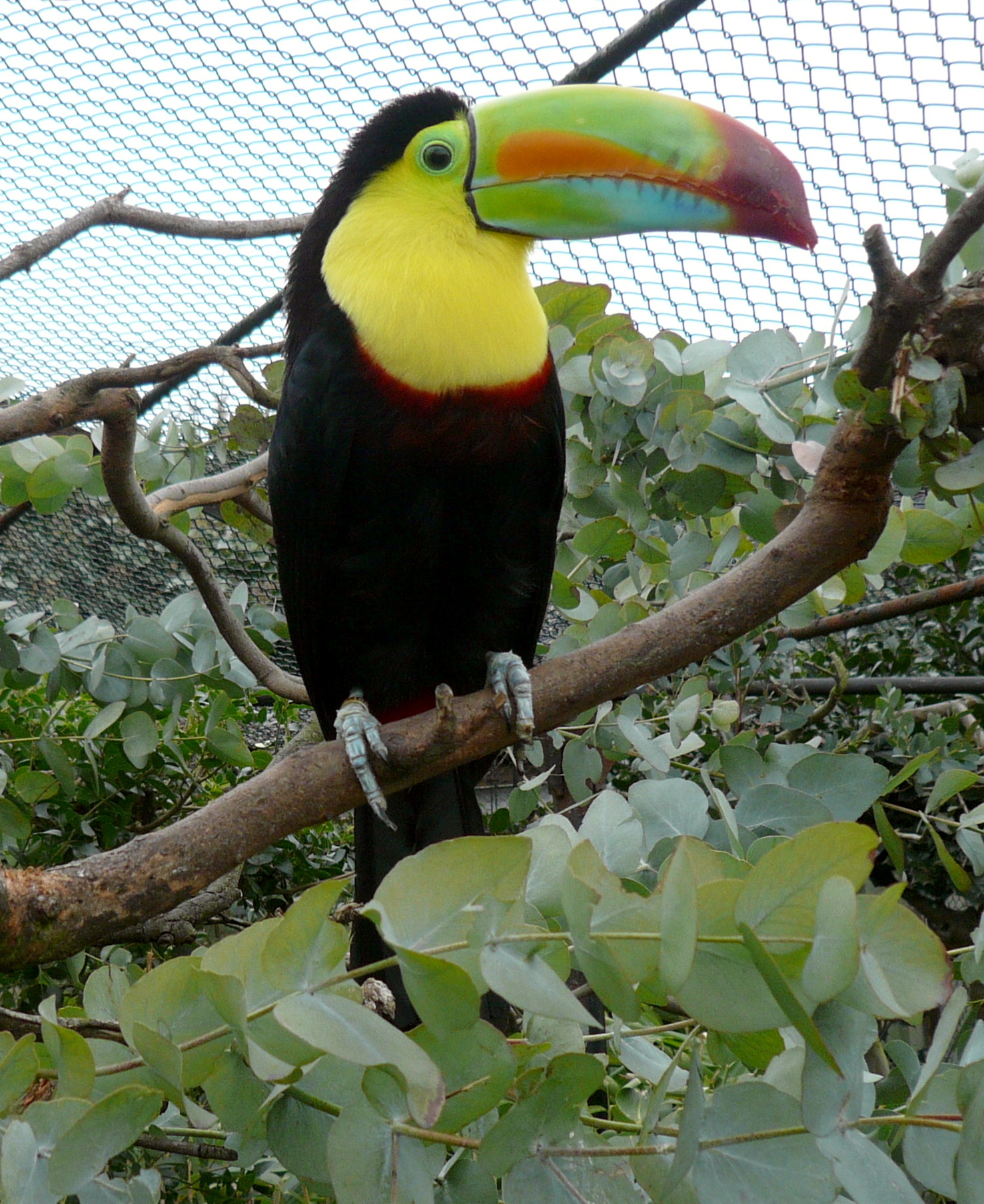- Keel-billed Toucan
Taxobox
name = Keel-billed Toucan

status = LC
status_system = iucn3.1
regnum =Animal ia
phylum =Chordata
classis =Aves
ordo =Piciformes
familia =Ramphastidae
genus = "Ramphastos "
species = "R. sulfuratus"
binomial = "Ramphastos sulfuratus"
binomial_authority = Lesson, 1830The Keel-billed Toucan ("Ramphastos sulfuratus"), also known as Sulfur-breasted Toucan, Rainbow-billed Toucan, is a colorful
South America nbird with a large bill. It is the national bird ofBelize . [Government of Belize : [http://www.belize.gov.bz/ab_symbols.html About Belize - National Symbols] . Retrieved 2007-02-08.]Description
Including its bill, the Keel-billed Toucans ranges in length from around 17 to 22 inches (42-55 cm). [Skutch (1971)] Their large and colorful bill averages around 5-6 in (12-15 cm), about one-third of its length. While the bill seems large and cumbersome, it is in fact a spongy, hollow bone covered in
keratin , a very light and hard protein.The plumage of the Keel-billed Toucan is mainly black with a yellow neck and chest. Molting occurs once per year.Van Tyne (1929)] It has blue feet and red feathers at the tip of its tail. The bill is mainly green with a red tip and orange sides.
Distribution and ecology
The Keel-billed Toucan can be found from Southern
Mexico toVenezuela andColombia . It roosts in the canopies of tropical, subtropical, and lowland rainforests, up to altitudes of 1,900 m. [Strewe & Navarro (2004)] It roosts in holes in trees, often with several other toucans. This can be very cramped, so the birds tuck their tails and beaks under their bodies to conserve space while sleeping. Adding to the lack of space, the bottoms of the holes are often covered with pits from the fruit the toucans have eaten.Like many toucans, Keel-billed is a very social bird, rarely seen alone. It travels in small flocks of approximately six to twelve individuals through lowland
rainforest s; it is a poor flyer, and moves mostly by hopping through trees. It has a family structure within the group. Birds will often "duel" with each other using their bills, and throw fruit into each other's mouths. As mentioned before, Keel-billed Toucans live together in these groups, often sharing cramped living quarters of holes in trees. Able to utiliuze human-alteredhabitat to some extent, [Foster (2007)] this widespread bird is considered to be a Species of Least Concern by theIUCN .IUCN2006|assessors=aut|BirdLife International|year=2004|id=47539|title=Ramphastos sulfuratus|downloaded=11 May 2006]Behaviour
Food and feeding
The diet of Keel-billed Toucans consists mostly of a wide range of
fruit , [E.g. "Cymbopetalum mayanum " (Annonaceae ) andGumbo-limbo ("Bursera simaruba"): Van Tyne (1929), Foster (2007).] but may also include bird eggs,insects ,lizards , and tree frogs. The bill, surprisingly dexterous, allows this toucan to utilize a large variety of fruit that might not otherwise be reached. When eating the fruit, the it uses its bill to pick the fruit, and then tosses its head back to swallow the fruit whole.Breeding
The female Keel-billed Toucan will usually lay a clutch of two to four (rarely one) white eggs. The male and female share in the caring of the eggs, both taking turns incubating. The eggs hatch approximately 15-20 days after being laid. After hatching, the male and female again take turns feeding the chicks. When the chicks hatch, they have no feathers, and have their eyes closed for approximately three weeks. The chicks have adequately formed heel pads, which assist on the pit-covered bottom of the nest. The chicks stay in their nest for approximately eight to nine weeks while their bills develop fully and they become ready to fly.
Aviculture
The Keel-billed Toucan is sometimes kept in captivity, but has a high fruit diet and is sensitive to
hemochromatosis (an iron storage disease).Fact|date=July 2008Footnotes
References
* (2007): The potential of fruiting trees to enhance converted habitats for migrating birds in southern Mexico. "Bird Conservation International" 17(1): 45-61. doi|10.1017/S0959270906000554 [http://journals.cambridge.org/production/action/cjoGetFulltext?fulltextid=936412 PDF fulltext]
* (1971): Life History of the Keel-billed Toucan. "Auk" 88(2): 381-396. [http://elibrary.unm.edu/sora/Auk/v088n02/p0381-p0396.pdf PDF fulltext]
* (2004): New and noteworthy records of birds from the Sierra Nevada de Santa Marta region, north-eastern Colombia. "Bull. B.O.C." 124(1): 38-51. [http://www.alpec.org/Articulo%20BBOC/Strewe%20&%20Navarro%202004%20BBOC%20124%20(1).pdf PDF fulltext]
* (1929): The Life History of the Toucan, "Ramphastos brevicarinatus". "University of Michigan Museum of Zoology Miscellaneous Publications" 19: 1-43.External links
* [http://www.emeraldforestbirds.com/EmeraldGallery.htm Extensive Gallery on Toucans]
* [http://actionnetwork.org/campaign/esa_senate/? Save the Endangered Species Act]
* [http://www.therainforestsite.com/cgi-bin/WebObjects/CTDSites The Rainforest Site]
* [http://rainforest.care2.com/ Race for the Rainforest]
* [http://ibc.hbw.com/ibc/phtml/especie.phtml?idEspecie=3735 "Ramphastos sulfuratus"-"Rainbow-billed Toucan" videos] on the Internet Bird Collection
* [http://www.bird-stamps.org/cspecies/10203100.htm Stamps] (7 countries)
* [http://vireo.acnatsci.org/search.html?Form=Search&SEARCHBY=Common&KEYWORDS=keel-billed+toucan&showwhat=images&AGE=All&SEX=All&ACT=All&Search=Search&VIEW=All&ORIENTATION=All&RESULTS=24 Keel-billed Toucan photo gallery] VIREO [http://vireo.acnatsci.org/species_image.php?species=Ramphastos+sulfuratus Photo-High Res]
* [http://www.diostede.com/collared_aracari_toucan/natural_history_literature/ramphastos_sulfuratus_sulfuratus_keel_billed_toucan.html Bibliography] of online, ornithological articles which explore the natural history of the Rainbow or Keel-billed toucan, "Ramphastos sulfuratus sulfuratus".
Wikimedia Foundation. 2010.
